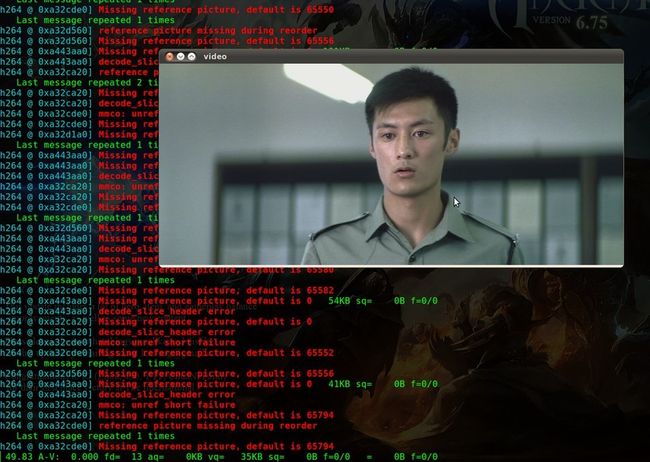ffmpeg 解复用视频文件
解复用视频文件:就是提取出音频文件和视频文件的ES流数据。而对于aac和h264来说,提取出来的数据直接保存并不能成功的播放,原因就在ffmpeg解出的ES数据比较纯净,没有ADTS头,而很多解码器都是需要ADTS头信息来进行解码的,所以就要对aac数据进行头部adts结构的添加。
对于h264文件来说,h264有两种封装,
一种是annexb模式,传统模式,有startcode,SPS和PPS是在ES中
一种是mp4模式,一般mp4 mkv会有,没有startcode,SPS和PPS以及其它信息被封装在container中,每一个frame前面是这个frame的长度
很多解码器只支持annexb这种模式,因此需要将mp4做转换:
在ffmpeg中用h264_mp4toannexb_filter可以做转换
实现:
注册filter
avcbsfc = av_bitstream_filter_init("h264_mp4toannexb");
转换bitstream
av_bitstream_filter_filter(AVBitStreamFilterContext *bsfc,
AVCodecContext *avctx, const char *args,
uint8_t **poutbuf, int *poutbuf_size,
const uint8_t *buf, int buf_size, int keyframe)
核心代码:
#include <libavformat/avformat.h>
#include <libavcodec/avcodec.h>
#include <stdio.h>
static int audioindex = -1;
static int videoindex = -1;
static int isaaccodec = -1;
int main(int argc ,char **argv)
{
av_register_all();
FILE *f = NULL;
FILE *g = NULL;
f = fopen("audio","wb");
g = fopen("video","wb");
if(!f || !g)
{
printf("open write file errorn");
return 0;
}
AVFormatContext *fmtctx = NULL;
AVPacket audiopack;
if(avformat_open_input(&fmtctx,argv[1],NULL,NULL) < 0)
{
printf("open fmtctx errorn");
return 0;
}
if(avformat_find_stream_info(fmtctx,NULL) < 0)
{
printf("find stream info n");
return 0;
}
int streamnum = fmtctx->nb_streams;
printf("stream num is %dn",streamnum);
int i=0;
for(;i<streamnum;i++)
{
if(fmtctx->streams[i]->codec->codec_type == AVMEDIA_TYPE_AUDIO && audioindex == -1)
{
audioindex = i;
}
else if(fmtctx->streams[i]->codec->codec_type == AVMEDIA_TYPE_VIDEO && videoindex == -1)
{
videoindex = i;
}
}
printf("audioindex is %dn",audioindex);
printf("videoindex is %dn",videoindex);
AVCodecContext *codecctx = fmtctx->streams[videoindex]->codec;
AVCodec *decode = avcodec_find_decoder(codecctx->codec_id);
AVCodecContext *audioCodecCtx = fmtctx->streams[audioindex]->codec;
AVCodec *audiodecode = avcodec_find_decoder(audioCodecCtx->codec_id);
if(audiodecode->id == AV_CODEC_ID_AAC)
{
isaaccodec = 1;
}
if(avcodec_open2(codecctx,decode,NULL) < 0)
{
return -1;
}
if(avcodec_open2(audioCodecCtx,audiodecode,NULL) < 0)
{
return -1;
}
printf("extradata size is %dn",audioCodecCtx->extradata_size);
AVBitStreamFilterContext* bsfc = av_bitstream_filter_init("h264_mp4toannexb");
AVBitStreamFilterContext* aacbsfc = av_bitstream_filter_init("aac_adtstoasc");
if(!bsfc || !aacbsfc)
{
return 0;
}
AVFrame picture;
while(!(av_read_frame(fmtctx,&audiopack)))
{
if(audiopack.stream_index == 1)
{
if(isaaccodec == 1)
{
char bits[7] = {0};
int sample_index = 0 , channel = 0;
char temp = 0;
int length = 7 + audiopack.size;
sample_index = (audioCodecCtx->extradata[0] & 0x07) << 1;
temp = (audioCodecCtx->extradata[1]&0x80);
switch(audioCodecCtx->sample_rate)
{
case 44100:
{
sample_index = 0x7;
}break;
default:
{
sample_index = sample_index + (temp>>7);
}break;
}
channel = ((audioCodecCtx->extradata[1] - temp) & 0xff) >> 3;
bits[0] = 0xff;
bits[1] = 0xf1;
bits[2] = 0x40 | (sample_index<<2) | (channel>>2);
bits[3] = ((channel&0x3)<<6) | (length >>11);
bits[4] = (length>>3) & 0xff;
bits[5] = ((length<<5) & 0xff) | 0x1f;
bits[6] = 0xfc;
fwrite(bits,1,7,f);
}
fwrite(audiopack.data,1,audiopack.size,f);
printf("audio pts is %fn",audiopack.pts*av_q2d(fmtctx->streams[audioindex]->time_base));
}
else if(audiopack.stream_index == videoindex){
AVPacket pkt = audiopack;
int a = av_bitstream_filter_filter(bsfc, codecctx, NULL, &pkt.data, &pkt.size, audiopack.data, audiopack.size, audiopack.flags & AV_PKT_FLAG_KEY);
if(a > 0)
{
audiopack = pkt;
}
fwrite(audiopack.data,1,audiopack.size,g);
int gotfinished = 0;
if(avcodec_decode_video2(codecctx,&picture,&gotfinished,&audiopack) < 0)
{
printf("decode video errorn");
}
if(picture.key_frame)
{
//printf("key framen");
}
else{
//printf("frame num is %dn",picture.pict_type);
}
//printf("video pts is %f, %dn",picture.pkt_dts * av_q2d(fmtctx->streams[videoindex]->codec->time_base),picture.pts );
}
av_free_packet(&audiopack);
}
fclose(f);
}
最后就可以用vlc 或ffplay来查看解析出来的音频aac文件和264文件,本套代码是通用解析器,任何视频文件都可以解析,只是对于264和aac单独做了处理。
贴上最后的效果图:
